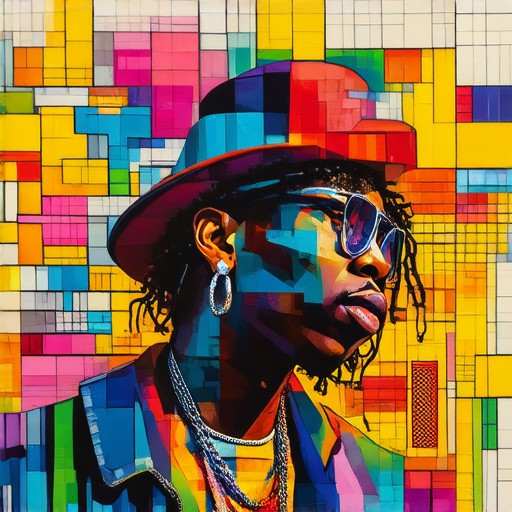Hip-hop culture, a vibrant tapestry woven with beats, rhymes, and stories, has transcended its roots in African American communities to become a global phenomenon. From its humble beginnings in the late 1960s to its current status as a dominant force in pop culture, hip-hop has evolved into a multifaceted movement that reflects the social, political, and economic struggles of marginalized communities. This article delves into the core characteristics and elements that define hip-hop culture, exploring its historical trajectory, societal impact, and global influence. By examining the key components of hip-hop, including its music, fashion, and linguistic expressions, we aim to provide a comprehensive analysis of its enduring legacy and the ways in which it continues to shape contemporary discourse. Whether you’re a seasoned fan or a curious newcomer, this exploration offers insights into the themes, trends, and transformations that have made hip-hop culture a cornerstone of modern life.
Key Takeaways
– Exploring Hip-Hop’s Rich History: From its origins in African American communities to its evolution into a global phenomenon, this article delves into the transformative journey of hip-hop culture.
– Understanding Its Cultural Depth: Discover how hip-hop addresses social issues, influences global pop culture, and fosters community connections through music and art.
– Fashion’s Role in Hip-Hop: Learn about the rise of streetwear, iconic artist collaborations, and how urban accessories have redefined modern fashion.
– The Business Behind the Beats: Uncover the economic power of hip-hop, including its impact on the music industry, streaming platforms, and brand sponsorships.
– Hip-Hop Goes Global: This article highlights how hip-hop transcends borders, adapting culturally while maintaining its core values in international markets.
– Innovation in Music Production: From beat-making software to AI integration, this piece explores how technology shapes hip-hop’s future.

Key Elements of Hip-Hop Culture Explored in Detail
Hip-hop culture is a vibrant and multifaceted phenomenon that extends far beyond music. Below are the primary elements that define this influential culture:
- Music : At its core, hip-hop is a musical art form characterized by rhythmic beats, lyrical storytelling, and unique vocal styles. From the boom bap beats of the late 1980s to modern trap and drill music, hip-hop continues to evolve while staying true to its roots.
- History and Evolution : The origins of hip-hop can be traced back to block parties in New York City during the late 1970s. Over time, it has spread globally, influencing countless genres and becoming a universal language of youth culture.
- DJing : Turntable scratching and mixing are integral to hip-hop, with DJs like Afrika Bambaataa pioneering the art form. This element remains central to live performances and competitions like the DMC World Championships.
- Lyrics and Storytelling : Rap lyrics often serve as a medium for social commentary, personal narratives, and artistic expression. Artists like Nas and Kendrick Lamar have used their words to address issues ranging from systemic inequality to personal struggles.
- Art and Visual Expression : Hip-hop has inspired various forms of visual art, including graffiti, street photography, and muralism. Artists like Jean-Michel Basquiat and Keith Haring blended music and art to create impactful works.
- Fashion : Streetwear has become synonymous with hip-hop culture, with brands like Supreme and Nike creating iconic designs. Rappers and athletes have played significant roles in shaping contemporary fashion trends.
- Social and Political Impact : Hip-hop has historically served as a platform for social commentary and activism. Artists like Public Enemy and Eminem have used their music to address racial injustice, economic disparities, and other societal issues.
- Global Influence : Hip-hop has transcended borders, influencing music, film, and even politics worldwide. Its influence on pop culture is undeniable, with international stars like BTS and Drake drawing inspiration from the genre.
- Evolving subgenres : From gangsta rap to alternative hip-hop, the genre has diversified while maintaining its core elements. Subgenres like lo-fi hip-hop and cloud rap have gained prominence in recent years.
Hip-hop culture is not just music; it’s a movement, a reflection of identity, and a celebration of creativity. By exploring these key elements, we gain a deeper understanding of its significance and enduring appeal.
Major Components of Hip-Hop Culture Explored in Detail
Hip-hop culture encompasses a multifaceted landscape that spans music, art, fashion, and social movements. Detailed articles often dive deep into key elements that define this vibrant cultural phenomenon:
- Music and Lyrics : The backbone of hip-hop, with intricate lyrics that tell stories, reflect personal experiences, and address societal issues. Artists use rhymes, rhythm, and beats to convey emotions and messages.
Complex explores how music production and lyrical content evolve across different regions and generations. - DJing : A cornerstone of hip-hop, DJing involves blending records to create unique sounds and rhythms. Articles often highlight the technical skills and creativity of DJs who shape the genre’s sound.
XXL delves into the history and significance of DJ culture in hip-hop. - Streetwear : Fashion plays a significant role, with urban clothing styles becoming synonymous with hip-hop culture. Brands like Supreme and Nike have capitalized on this trend.
Vulture covers how streetwear bridges music and fashion. - Storytelling : Many hip-hop artists use their music as a medium for storytelling, sharing personal narratives or social commentary. Articles often analyze how this aspect contributes to the genre’s appeal.
HuffPost discusses the power of storytelling in hip-hop. - Social Impact : Hip-hop has long been a platform for addressing systemic issues, promoting social change, and challenging societal norms. Articles frequently examine the genre’s role in activism and community building.
Rolling Stone explores how hip-hop influences social movements. - Iconic Dances : Moves like the Breakdance and Moonwalk are integral to hip-hop culture. Articles often trace the evolution of dance styles and their influence on music videos and performances.
Billboard highlights the importance of dance in hip-hop history. - Cultural Evolution : As hip-hop globalizes, it absorbs influences from various cultures while maintaining its core identity. Articles discuss how this fusion shapes the genre’s future directions.
NPR examines the global impact of hip-hop and its adaptability.

How Hip-Hop Articles Explore and Analyze the Evolving Nature of Hip-Hop Culture
Hip-hop articles delve deeply into the multifaceted nature of hip-hop culture, examining its roots, current state, and future trajectory. These articles often serve as lenses to understand the art form’s evolution, its impact on society, and its role in shaping contemporary culture.
The Origins and Foundational Elements
Hip-hop articles frequently trace the origins of the genre, from its beginnings in the Bronx during the late 1970s to its global influence today. They explore the cultural pillars that define hip-hop, including DJing, MCing, beatboxing, and streetwise storytelling. These pieces often highlight how the genre emerged as a form of resistance and self-expression, reflecting the struggles and triumphs of marginalized communities.
Cultural Impact and Influence
Hip-hop articles also examine the genre’s profound impact on music, fashion, language, and social movements. They discuss how hip-hop has influenced mainstream culture, from its role in the rise of urban fashion to its contribution to political discourse. Many articles explore how hip-hop bridges gaps between generations and fosters cross-cultural dialogue.
Social and Political Analysis
Many hip-hop articles focus on the genre’s role as a mirror and catalyst for societal change. They analyze how hip-hop artists use their platforms to address issues like systemic inequality, police brutality, economic disparity, and social justice. These analyses often reveal the genre’s power to inspire collective action and spark meaningful conversations.
Technological Advancements and Innovation
As hip-hop evolves, articles explore how technology has shaped the genre. From the rise of digital audio workstations to the rise of streaming platforms, these pieces discuss how innovation has redefined production techniques and consumption habits. They also examine the role of social media in propagating hip-hop culture worldwide.
Global Reach and Fusion with Other Genres
Hip-hop articles highlight the genre’s global influence, showcasing how it has adapted and blended with cultures around the world. They explore fusion genres like trap, lo-fi, and Afrobeats, demonstrating how hip-hop continues to innovate and connect with diverse audiences. These articles often feature comparisons to other music forms, illustrating hip-hop’s universal appeal.
The Future of Hip-Hop Culture
Looking ahead, hip-hop articles speculate on the genre’s future, considering trends like AI-driven music production and the integration of VR and AR technologies. They also discuss the potential for hip-hop to address emerging challenges, such as climate change and technological ethics. These forward-looking pieces aim to inspire the next generation of hip-hop creators and fans.
Hip-hop articles are not just about music—they’re about storytelling, reflection, and cultural critique. By exploring these aspects, they provide readers with a deeper understanding of hip-hop’s past, present, and future, while fostering appreciation for its enduring influence on global culture.

Themes and Elements Explored in Hip-Hop Culture Articles
- The Evolution of Music and Artistry
- Historical origins of hip-hop in African American communities
- Development of rap and DJ culture
- Modern advancements in music production techniques
- Cultural Impact and Social Commentary
- Addressing social issues through music and lyrics
- Exploration of race, identity, and systemic inequalities
- Influence of hip-hop on global pop culture
- Fashion and Lifestyle
- Streetwear trends and their historical context
- Impact of hip-hop artists on high fashion
- Urban accessories and their cultural significance
- Societal Influence and Business Aspects
- Economic impact of hip-hop on the music industry
- Role of streaming platforms in popularizing hip-hop
- Brand collaborations and sponsorships
- Globalization and Cross-Cultural Exchange
- Hip-hop’s influence in international markets
- Cultural adaptations in different regions
- Collaborations between hip-hop artists and global stars
- Technology and Innovation
- Use of beat-making software and digital tools
- Integration of AI in music production
- Virtual concerts and live-streaming innovations
Aozzora highlights these themes through in-depth articles that explore the intersection of music, culture, and technology. By covering these elements, we provide readers with a comprehensive understanding of hip-hop’s past, present, and future impact.
What Aspects of Hip-Hop Culture Do Detailed Articles Commonly Explore?
Hip-hop culture is a multifaceted phenomenon that encompasses various elements, each contributing to its unique identity. Detailed articles often dive deep into:
- Music : Exploring the evolution of genres like rap, trap, drill, and cloud rap. Analyzing lyrical themes, storytelling techniques, and the influence of producers and beatmakers.
- History : Tracing the origins of hip-hop in the Bronx, New York City, during the late 1960s and early 1970s. Examining key figures like DJ Kool Herc, Grandmaster Flash, and Afrika Bambaataa who laid the foundation.
- Fashion : Discussing streetwear styles, brand collaborations, and the rise of urban clothing as a cultural icon. Highlighting iconic looks from artists like Kanye West and Travis Scott.
- Social Impact : Assessing the role of hip-hop in addressing societal issues such as systemic racism, economic inequality, and political activism through lyrics and public discourse.
- Influences : Investigating how hip-hop has impacted global music, fashion, and pop culture. Exploring its reach in countries like Japan, South Korea, and beyond.
Detailed articles also often touch on the cultural significance of hip-hop, including its role in fostering community, preserving heritage, and serving as a platform for marginalized voices. Platforms like Complex , XXL , and Vulture regularly publish in-depth pieces that explore these aspects and more, providing readers with a well-rounded understanding of hip-hop culture.

What Are the Common Themes and Aspects Explored in Hip-Hop Culture Articles?
Hip-hop culture is a multifaceted subject that encompasses various dimensions, each contributing to its rich tapestry. Below are the primary themes and aspects typically explored in hip-hop culture articles:
- Music : – Beats and Rhythms : Discussions often revolve around the unique drum patterns, basslines, and sampling techniques that define hip-hop production. – Lyrics and Storytelling : The narrative aspect of rap lyrics, where artists share personal stories, societal critiques, and cultural reflections. – Artists and Movements : Profiles of influential hip-hop artists, genres like trap music, and the evolution of subcultures such as drill music. – Collaborations : Features between artists, producers, and even cross-genre collaborations, which push creative boundaries.
- Fashion : – Streetwear : The rise of urban clothing styles, including hoodies, sneakers, and graphic tees. – Accessories : Custom jewelry, hats, and other wearable items associated with hip-hop culture. – Brand Collaborations : High-profile partnerships between hip-hop artists and fashion labels.
- History : – Origins : The roots of hip-hop in African American communities during the late 20th century. – Key Movements : Major eras like the Golden Age of Hip-Hop in the 1980s and the rise of conscious rap in the 1990s. – Influential Figures : Icons like DJ Kool Herc, Tupac Shakur, and Nas who shaped the culture.
- Social Impact : – Community Building : How hip-hop fosters connections within urban neighborhoods. – Activism : The role of hip-hop in addressing social issues such as police brutality, systemic inequality, and political awareness. – Economic Influence : The economic power of hip-hop, from record sales to merchandise and live performances.
- Global Influence : – Cultural Exportation : How hip-hop has influenced music, fashion, and language worldwide. – International Adaptations : The localization of hip-hop in countries like Japan, South Korea, and the UK. – Dance Styles : Moves like breakdancing and krumping that have gone global.
For deeper exploration, consider visiting platforms like Aozzora for curated insights and updates on hip-hop culture. Whether you’re a fan or researcher, these articles offer a gateway to understanding the multifaceted nature of this dynamic cultural force.





0 Comments